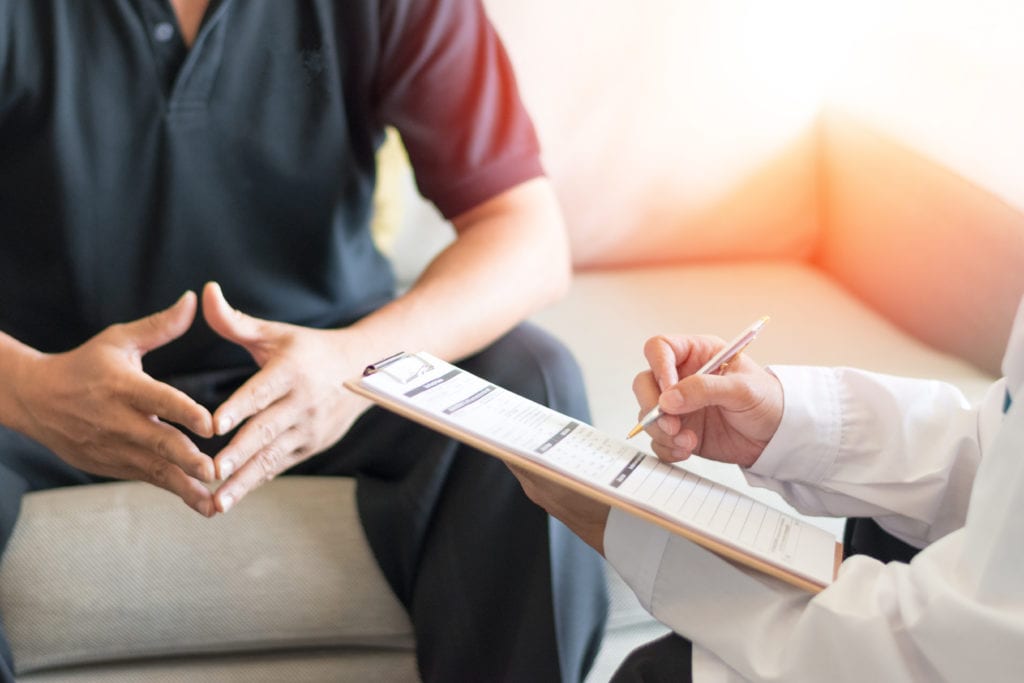Holmium Laser Enucleation in Chattanooga & East Ridge, TN
One thing that most men can anticipate as they get older is having issues with an enlarged prostate gland. Benign prostatic hyperplasia (BPH) is the clinical term for an enlarged prostate. BPH causes many uncomfortable or irritating symptoms involving the male urinary system, such as decreased urine flow and frequent need to urinate.
Dr. Anand Shridharani, a board-certified urologist, treats BPH with advanced services like holmium laser enucleation of the prostate (HoLEP). He cares for patients in Chattanooga, Tennessee, helping them manage BPH with the latest techniques.
WHAT IS HOLMIUM LASER ENUCLEATION OF THE PROSTATE?
An enlarged prostate is a common condition in aging men. The prostate grows, and it begins to push on the urethra and decrease the urine flow, leading to:
- Frequent need to urinate
- Inability to urinate
- Difficulty in starting urination
- Loss of bladder control
This is not prostate cancer; it is simply an enlarged prostate, also called BPH.
Different surgeries have been used to treat BPH for years, with options like laser ablation and transurethral resection of the prostate.
Holmium laser enucleation of the prostate (HoLEP) is another type of surgical laser developed in the mid-1990s. Over the past 20+ years, this laser has shown to be very effective for urological surgery.
In this particular procedure, the laser energy cuts away the prostate tissue that is pushing on the urethra and blocking the flow of urine. It allows Dr. Shridharani to remove larger prostate tissue more precisely, with less bleeding and faster recovery compared to earlier surgical methods.
WHO IS A GOOD CANDIDATE FOR THE HOLEP PROCEDURE?
If you have an enlarged prostate that is pressing on your urethra, odds are you’re a good candidate for HoLEP. You may be having difficulty passing urine. BPH occurs in over 40 percent of men over the age of 60, and symptoms usually worsen with age.
There are some options for treating BPH without surgery, but when those treatments don’t work, surgery is usually necessary to avoid problems with urine retention and bladder stones.
Certain patients may not be eligible for HoLEP:
- If you have bleeding problems
- If you’ve had certain types of prior prostate treatments
- If you cannot lie on your back with your legs raised (the position required for HoLEP)
WHAT HAPPENS DURING THE HOLEP PROCEDURE?
During the HoLEP procedure, you will be under general anesthesia, so you’ll be completely asleep and won’t feel anything. Here’s what to expect:
- Positioning: You’ll be positioned on your back with your legs raised.
- Resectoscope Insertion: Dr. Shridharani will insert a surgical instrument called a resectoscope through your urethra. This device has a camera, allowing him to see the internal structure of your prostate and plan where to make incisions.
- Laser Enucleation: The surgeon then inserts the laser into the resectoscope. He uses the laser to cut away the enlarged prostate tissue. The laser seals blood vessels as it cuts, minimizing bleeding.
- Tissue Removal: The removed tissue is sent into your bladder, and the laser is replaced with a tool called a morcellator, which suctions out the tissue.
- Completion: Once the tissue is removed, Dr. Shridharani takes out the resectoscope and places a urinary catheter to help you urinate while you heal.
HOW IS HOLEP DIFFERENT THAN LASER ABLATION?
Laser ablation, or laser vaporization, burns away small areas of the prostate tissue. This can work well if only a small amount of tissue needs to be removed. However, if your prostate is much larger, laser ablation may not be able to remove enough tissue, and your symptoms could return over time.
HoLEP is different because it cuts away and completely removes the larger areas of prostate tissue that are causing problems. This makes it a better option for men with more significant prostate enlargement. Since HoLEP removes the tissue entirely, it often provides longer-lasting relief and lowers the chances of needing another surgery.
WHAT IS RECOVERY LIKE AFTER HOLEP TREATMENT?
After your HoLEP treatment, you’ll be admitted to the hospital overnight for observation and catheter care. Some bleeding from the prostate is to be expected, but this clears in 12 hours for most patients. Fluid will be flushed through the catheter to clear blood from the urine after your surgery.
The morning after your surgery, we’ll remove the catheter. If you are able to urinate well at least two to three times, you are cleared to go home without the catheter. If you cannot urinate, we’ll replace the catheter and it will stay in for one week.
Urinating will likely be painful at first, and you’ll need to go more frequently. In a few days, these issues should improve. We encourage you to drink plenty of fluids once the catheter is removed to help clear blood from your urine.
It can take several months for symptoms such as frequency, urgency, and waking at night to urinate to permanently improve. Your bladder needs to adjust to the removal of the prostate tissue, and the surgery can temporarily weaken muscle control in the pelvic area.
WHAT ARE THE SIDE EFFECTS WITH HOLEP?
You may experience some mild side effects with HoLEP, but they should go away in time. The side effects may be:
- Temporary burning and bleeding during urination: Blood may be in your urine for several weeks.
- Urinary incontinence: All patients should expect this immediately after surgery. Plan on wearing pads for a period of days or possibly weeks.
- Backwards ejaculation: Three-quarters of patients will not see any fluid during ejaculation during sexual activity after surgery.
WHAT ARE THE RISKS WITH HOLEP?
HoLEP carries some risks, but they are rare. It’s important to know of these potential risks before deciding on treatment. Dr. Shridharani will discuss them with you and take steps to minimize them during your procedure. Some possible risks include:
- Injury to the urethra or development of scar tissue
- Injury to the bladder or ureteral orifices
- Bladder, testes, or kidney infection
- Return of urinary obstruction
- Need for transfusion due to bleeding
- Failure to relieve all symptoms
- Need for prolonged catheterization
WHY CHOOSE DR. SHRIDHARANI?
Dr. Anand Shridharani is a board-certified urologist with specialized training in male reproductive and prosthetic urology. With years of experience, he’s highly skilled in advanced treatments like HoLEP, offering a minimally invasive solution for BPH. He also specializes in many other treatments like erectile dysfunction, vasectomy reversal, male infertility, and penile implantation, providing comprehensive care for men’s health.
At his practice in Chattanooga, Dr. Shridharani wants you to feel educated and involved in your urological care so you are comfortable with your treatment plan. With a friendly, down-to-earth approach, he’ll make your experience as smooth and stress-free as possible.
FREQUENTLY ASKED QUESTIONS
How Long Does the HoLEP Procedure Usually Take?
The HoLEP procedure typically takes one to two hours, depending on the size of the prostate.
How Should I Prepare for the HoLEP Procedure?
You’ll need to fast for several hours before the procedure and follow any specific instructions from Dr. Shridharani, such as stopping certain medications.
Are There Any Restrictions on Physical Activity After HoLEP?
Yes, you should avoid strenuous activities for two to four weeks and follow Dr. Shridharani’s guidance on when to resume normal activities.
Is HoLEP a Permanent Solution for BPH, or Can Symptoms Return?
HoLEP is a long-lasting solution for most patients, with a low chance of symptoms returning.
HoLEP Testimonials
- “Dr Shridharani performed the HoLEP Procedure on me April of 2018. I was treated with nothing but respect and given answers to all my questions. I have had no problems and two weeks after the surgery I am doing fanstastic. I would recommend Dr. Shridharani for this procedure wirh a high level of confidence. My after surgery results were very postive and more than expected. Thank you so much Dr. Shridharani for an excellent job well done.” – Bill C.
- “I needed prostate surgery. I’ve been shown genuine concern for my well-being before, during, and still after the surgery. A special group of professionals in this clinic.“- Steve W.
Schedule Your Consultation Today!
If you’re interested in learning more about how the HoLEP procedure can help with your BPH symptoms, Dr. Shridharani and his team are here to guide you. Call 423-778-4636 to schedule a consultation and get expert holmium laser treatment in Chattanooga, TN.



